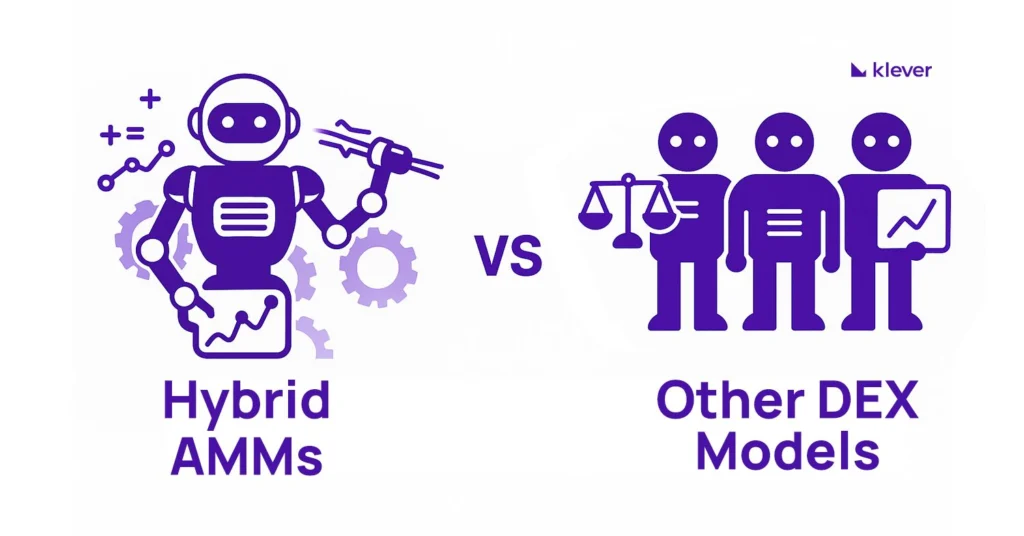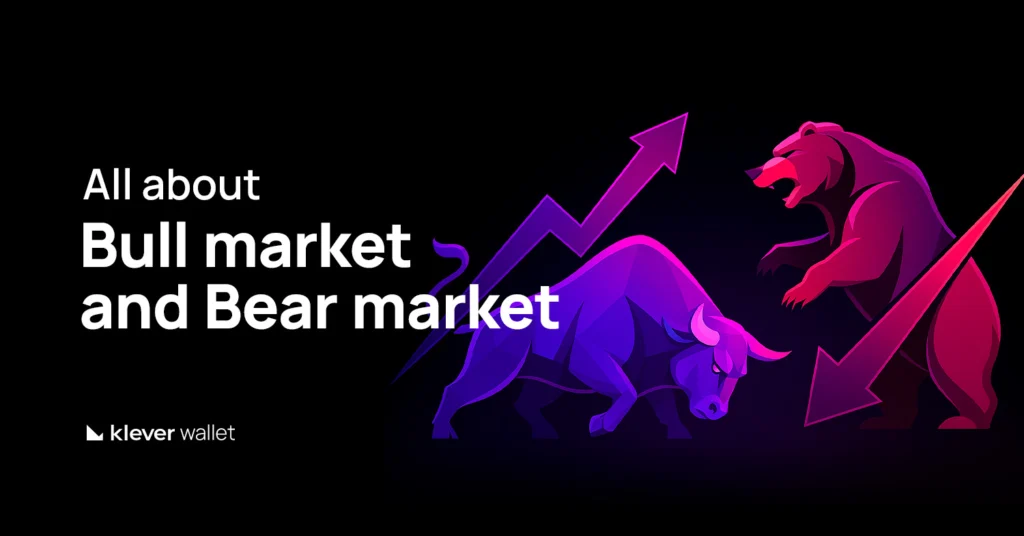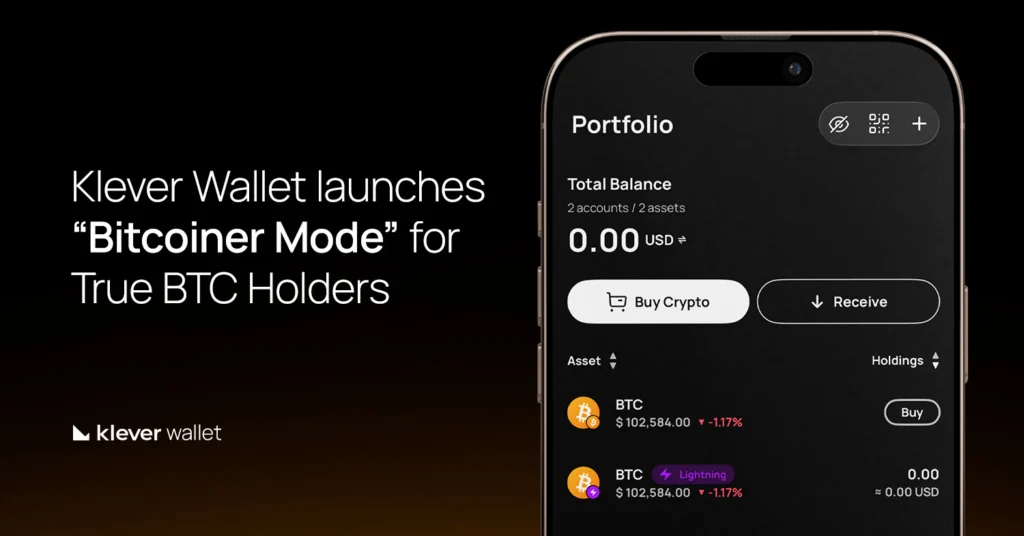
Decentralized exchanges (DEXs) have become a core part of the DeFi ecosystem, enabling peer-to-peer token swaps without relying on centralized intermediaries.
But not all DEXs work the same way. Behind the scenes, they use different models to set prices, manage liquidity, and execute trades.
The most common types include automated market makers (AMMs), order book-based systems, request-for-quote (RFQ) protocols, and aggregators.
More recently, hybrid AMMs have emerged, combining the strengths of multiple models to improve trade execution, capital efficiency, and flexibility.
This article explores how hybrid AMMs compare to other decentralized exchange designs, breaking down how each model works, where it performs best, and what trade-offs users should understand.
What You’ll Learn in This Article
- The Building Blocks of a DEX
- DEX Model Landscape
- How Hybrid AMMs Work
- Comparison — Hybrid AMMs vs Other Models
- How to Choose the Right DEX Model
- Why Hybrid AMMs Are Gaining Ground
- Frequently Asked Questions (FAQ)
The Building Blocks of a DEX
Before diving into how hybrid AMMs stand out, it helps to understand the fundamental models that power most decentralized exchanges today.
From automated market makers (AMMs) to order books and dynamic pricing systems, each model plays a distinct role in how trades are priced, executed, and settled on-chain.
What Is an AMM?
An Automated Market Maker (AMM) is a system that allows users to swap tokens directly through liquidity pools, rather than relying on an order book or a direct counterparty.
Prices are set by a mathematical formula, the most common being the constant product model:
x * y = k
In this equation:
- x is the quantity of one token in the pool
- y is the quantity of the other token
- k is a fixed constant that must remain the same after every trade
This formula powers platforms like Uniswap and PancakeSwap. It adjusts token prices automatically based on the ratio of assets in the pool.
While effective for volatile tokens, this model can cause slippage on large trades.
Some AMMs use a constant sum formula instead, which works better for stablecoins or assets with similar value.
x + y = k
This creates a flatter pricing curve, ideal for stable assets with nearly equal value. It reduces slippage but breaks down if asset prices diverge significantly.
What Is an Order Book?
Order book-based exchanges follow a traditional model where traders place buy and sell orders at specific prices.
The exchange matches these orders when they align. On-chain order book DEXs bring this mechanism to DeFi, offering precision and flexibility for advanced users.
While this system gives more control, it also introduces complexity and often requires active liquidity management.
What Makes a DEX “Hybrid”?
Hybrid AMMs blend the core principles of AMMs with features from other models like order books or RFQ systems. They may dynamically switch pricing curves, connect to external liquidity sources, or adapt to market conditions in real time.
The goal is to combine the simplicity of AMMs with the precision and depth of more complex systems, offering a smarter and more versatile DEX infrastructure.
DEX Model Landscape
Decentralized exchanges come in many forms, each using different mechanisms to manage liquidity, set prices, and execute trades.
Some follow a single, fixed approach, while others integrate more dynamic or hybrid strategies.
This section breaks down the most common DEX models: how they work, where they excel, and where they fall short.
Single-Model AMMs
These use one fixed pricing formula for all trades. The most common is the constant product model (x * y = k), used by Uniswap v2 and similar DEXs. While reliable and easy to use, they don’t adjust to asset types or volatility levels.
- Strengths: Simplicity, proven model, low technical risk
- Limitations: Higher slippage on large trades, not ideal for stable assets
- Example: Uniswap v2 and PancakeSwap are classic single-model AMMs. They work well for most retail trades but struggle with capital efficiency and price precision in certain scenarios like stablecoin swaps or large orders.
Order Book-Based DEXs
These mimic centralized exchange behavior but run on-chain. Users place bids and asks, and the platform matches orders.
- Strengths: Precise control, deep liquidity for high-volume traders
- Limitations: More complex interface, requires active management
- Example: Raydium on Solana combines AMM functionality with Serum’s order book, giving users access to both liquidity sources in one interface.
RFQ (Request for Quote) Protocols
Rather than using curves or order books, RFQ systems let users request a price from a market maker. If accepted, the trade executes at that price.
- Strengths: Great for large trades, often lower slippage
- Limitations: Less transparent, depends on external market makers
- Example: Matcha by 0x uses an RFQ system that sources quotes from off-chain market makers. When better prices are available than through AMMs, it executes the trade at the quoted rate,offering more efficient execution for high-volume swaps.
Aggregator DEXs
These platforms don’t provide liquidity themselves. Instead, they route trades through multiple sources to find the best price.
- Strengths: Optimal pricing, efficient routing
- Limitations: Relies on the performance of other DEXs
- Example: VoxSwap is a multi-chain aggregator that allows users to swap across more than 40 blockchains without needing to connect an extension wallet. It blends aggregation and hybrid routing logic to improve user experience.
Intent-Based DEXs (Emerging)
These platforms focus on user outcomes rather than trade structure. A user defines what they want (e.g., “swap 100 USDC for the best ETH”), and solvers compete to fulfill it.
- Strengths: Abstraction of complexity, future-focused design
- Limitations: Still experimental and limited in scope
- Example: CoW Swap is a leading intent-based DEX built on top of Gnosis. It batches user intents and uses solvers to find optimal execution paths, often across multiple liquidity sources, while minimizing MEV (Miner Extractable Value).
Off-Chain Matching with On-Chain Settlement
Some DEXs use off-chain systems for speed and on-chain smart contracts for final settlement. Examples include zk-rollups and some Cosmos-based exchanges.
- Strengths: High throughput, reduced gas costs
- Limitations: May reduce decentralization or transparency
- Example: dYdX (v3) uses off-chain order books and matching engines to offer low-latency trading. Once orders are matched, trades are settled on-chain via Ethereum smart contracts, combining performance with trustless settlement.
Wallet-Integrated DEXs
Some platforms, like Klever Swap, are integrated directly into crypto wallets, allowing users to swap assets from multiple blockchains without leaving the app. While these may appear simple on the surface, they often rely on hybrid models behind the scenes to optimize routes and fees.
- Strengths: Seamless user experience, cross-chain support
- Limitations: Execution logic may be abstracted from the user
How Hybrid AMMs Work
Hybrid AMMs are built to address the limitations of single-model DEXs by introducing flexibility in how trades are priced and executed. Instead of relying on one formula for every transaction, they adjust their logic based on factors like asset type, liquidity depth, volatility, or trade size.
Blending Core Pricing Models
Hybrid AMMs typically combine the following mechanisms:
- Constant Product: Used for volatile assets. Prices shift as pool balances change.
- Constant Sum: Used for stable pairs. Keeps prices close to 1:1 with minimal slippage.
- Order Book Routing: Some hybrid AMMs tap into on-chain order books for additional price discovery and deeper liquidity.
This mix allows hybrids to optimize pricing whether the user is trading volatile pairs, stablecoins, or large orders.
Adapting in Real Time
What sets hybrid AMMs apart is not just the formulas they use, but how they adjust dynamically based on trade conditions:
- Switching between pricing curves depending on asset behavior
- Routing trades externally when better pricing is available
- Using virtual balances to simulate deeper liquidity
This responsiveness ensures that the AMM stays efficient without needing manual reconfiguration.
Examples of Hybrid AMMs in Action
- Curve (StableSwap): Blends constant product and constant sum for stablecoin pairs
- KyberSwap (DMM): Adjusts fees based on token volatility
- Balancer: Allows customizable pool weights and programmable logic
- Raydium: Combines AMM pools with Serum’s order book
- VoxSwap: Integrates hybrid routing across 40+ blockchains
- Klever Swap: Embedded within a wallet, using routing and liquidity logic to optimize trades seamlessly
These platforms reflect the many ways hybrid design can improve the DEX experience without sacrificing speed or decentralization.
Comparison — Hybrid AMMs vs Other Models
| Feature | Hybrid AMMs | Single-Model AMMs | Order Book DEXs | RFQ | Aggregators |
| Price execution | High | Medium | High | High | High |
| Capital efficiency | High | Low/Medium | Medium | Medium | Depends |
| Liquidity depth | High | Medium | High | Medium | High |
| Asset flexibility | High | Low/Medium | Medium | Medium | High |
| User experience | Moderate to Easy | Easy | Complex | Easy | Easy |
| Adaptability | Dynamic | Static | Manual | Fixed quotes | Depends |
How to Choose the Right DEX Model
With so many DEX designs available, AMMs, hybrids, order books, aggregators, it’s important to understand when to use each model based on your trading goals.
Whether you’re prioritizing low slippage, cross-chain access, or ease of use, the ideal DEX model changes depending on the context. This section breaks down which models work best for specific scenarios.
Stablecoin Swaps
- Best Choice: Hybrid AMMs (e.g., Curve’s StableSwap), or single-model AMMs with constant sum curves
- Why: Low slippage when assets are closely pegged
Volatile Token Swaps
- Best Choice: Constant product AMMs or dynamic models like Kyber’s DMM
- Why: Handles market movement and volatility
Large Trades
- Best Choice: Hybrid AMMs with order book integration like Raydium or RFQ models
- Why: Better execution and reduced slippage
Cross-Chain Swaps
- Best Choice: Aggregator DEXs or multi-chain hybrids like VoxSwap
- Why: Optimized routing across chains
DAO or Index Strategy
- Best Choice: Custom weighted pool AMMs like Balancer
- Why: Programmable liquidity logic and flexible token ratios
Beginner-Friendly Swaps
- Best Choice: Wallet-integrated hybrid AMMs, such as Klever Swap
- Why: Simple, no extensions or technical setup needed
Why Hybrid AMMs Are Gaining Ground
Decentralized exchanges continue to evolve beyond basic AMM designs. Hybrid AMMs offer a powerful blend of pricing strategies, liquidity access, and adaptive behavior that solve many of the pain points in earlier models. While single-model AMMs remain popular for their simplicity, and order book or RFQ-based systems offer precision, hybrid models stand out for their flexibility.
From Curve and Balancer to Raydium, VoxSwap, and Klever Swap, the hybrid AMM landscape continues to grow, bridging the gap between performance and usability.
Whether you’re a DeFi newcomer or building complex liquidity systems, understanding these models helps you make more informed, strategic decisions. Always Do Your Own Research before compromising any money.
Try It Yourself — Use Klever Wallet
Swap assets with ease using the Klever Wallet app or browser extension. Access hybrid AMM logic, multi-chain support, and secure transactions—all in one place with a user friendly interface
Frequently Asked Questions (FAQ)
What is a hybrid AMM in simple terms?
A hybrid AMM is a decentralized exchange model that blends different pricing and liquidity systems—like constant product, constant sum, and order books—to improve trade execution and reduce slippage.
How is a hybrid AMM different from a DEX aggregator?
An aggregator scans multiple DEXs to find the best price. A hybrid AMM typically handles pricing and routing within its own system but may include dynamic logic similar to aggregators. VoxSwap, for example, combines both approaches.
Are hybrid AMMs more expensive to use?
Not necessarily. Many hybrid AMMs reduce fees by minimizing slippage. Some models also adjust fees based on market conditions, benefiting both traders and liquidity providers.
Do I need to understand all this to use a DEX?
No. Most modern DEXs, especially hybrid ones, handle everything behind the scenes. But knowing how they work helps you choose the right one for your needs.
Is Klever Swap a hybrid AMM?
Yes. While its interface is wallet-based and beginner-friendly, it uses hybrid logic behind the scenes to optimize routing, fees, and execution.
Which DEX model is the best?
There is no one-size-fits-all. Hybrid AMMs are usually the most adaptable, but depending on your goals, a simple constant product AMM or a focused order book DEX might be the better choice.
Disclaimer: This content is for informational purposes only and does not constitute financial advice. Always do your own research (DYOR) before making any investment or trading decisions.




